The Combined Effects of the Thermal Environment and Air Quality at Recreation Places on the Physiology and Psychology of People in Urban Parks
Abstract
:1. Introduction
- (1)
- The relationship between thermal environmental parameters, public physiological and psychological indicators, and their impact on health;
- (2)
- The relationship between air quality indicators, public physiological and psychological indicators, and their impact on health;
- (3)
- How the thermal environment and air quality of urban forest recreation places comprehensively influence the physiological ease and psychological health of the people.
2. Materials and Methods
2.1. Study Site Overview
2.2. Sample Sites Setting
- A type with a high green view rate and a large proportion of site area, which, through expert scene judgment, is defined as open recreation places: these are open and spacious recreational spaces within urban parks, such as recreational platforms and squares;
- Park spaces with a high green view rate and narrow lines of sight, which are defined as forest recreation places: these are the wooded recreational areas within urban parks;
- Spaces that are relatively open with the presence of large water bodies are defined as waterfront recreation places. The classification is based on the type of urban park;
- A cluster with relatively high values of spatial elements, which, through scene judgment, is defined as canopy recreation places: scenes that are located at the canopy level or on the top or mid-levels of mountain parks, where the viewing points are above the canopy with a broad range of visibility.
2.3. Overall Experimental Design
2.4. Environmental Quality Monitoring Method
- Accuracy and Precision: We meticulously chose devices that boast high levels of accuracy and precision, ensuring that the measurements correspond closely with the actual environmental conditions;
- Sensitivity and Response Time: Our sensors were selected for their sensitivity to minute environmental changes and rapid response times, allowing for the precise capture of dynamic variations within the urban forest microclimate;
- Ease of Calibration and Maintenance: We favored equipment that requires infrequent calibration and minimal maintenance, thereby reducing the potential for human error and ensuring uninterrupted data collection;
- Environmental Durability: Considering the outdoor setting of our study, the equipment’s resilience to environmental factors such as temperature fluctuations and humidity was a mandatory criterion;
- User-friendliness: The operability of the devices was also taken into account, with a preference for those that offer an intuitive user interface to facilitate ease of use by research personnel.
2.5. Measurement of Physiological Data from the Public
2.6. Questionnaire Survey
2.7. Subjects
- Physiological Consistency: By focusing on a younger adult population, we aimed to achieve a more uniform baseline of physiological responsiveness, which is less likely to be complicated by age-related health issues;
- Health Bias Mitigation: The exclusion of participants with chronic health conditions was essential to prevent potential biases that could skew the interpretation of the effects of the urban forest environments on physiological and psychological well-being;
- Complex Health Variable Elimination: Chronic illnesses and their associated treatments can introduce a myriad of health variables that may interact with the environmental factors under investigation, thereby obfuscating the study’s findings;
- Enhanced Feasibility: Targeting a younger, healthier demographic also enhanced the feasibility of the study, as this group is generally more accessible and willing to participate in research endeavors;
- Broader Generalizability: By eliminating individuals who might exhibit atypical responses due to health conditions, the generalizability of our findings to a similar young adult population is strengthened.
2.8. Experimental Procedure
2.9. Analytical Methods
3. Results
3.1. Base Environmental Conditions
3.2. Effect of Thermal Environment and Air Quality on Public Physiological Indicators
3.2.1. Effects on HR
3.2.2. Effects on the Heart Rate LF/HF Balance
3.2.3. Effects on EDA
3.3. Effect of Thermal Environment and Air Quality on Public Psychological Indicators
3.3.1. Spiritual Vitality
3.3.2. Stress Relief
3.3.3. Emotional Arousal
3.3.4. Attention Recovery
3.4. Regression Analysis of Thermal Environment and Air Quality on Public’s Physiological and Psychological Responses
4. Discussion
4.1. Thermal Environmental Factors and Physiological-Psychological Indicators
4.2. Effects of Recreation Place Type on Psychological Well-Being
4.3. Air Quality and Physical-Mental Health
4.4. The Practical Significance of Urban Forest Management
4.5. Shortcomings and Prospects
5. Conclusions
- (1)
- Impact of Environmental Conditions on Physiological Indicators: A significant influence on public physiological metrics such as heart rate (HR), heart rate variability ratio (LF/HF), and electrodermal activity (EDA) was observed across different recreation place types. Woodland recreation places were particularly effective in reducing HR and enhancing the LF/HF ratio, while waterfront recreation places demonstrated a notable impact in reducing EDA.
- (2)
- Impact of Environmental Conditions on Psychological Indicators: Forest and waterfront recreation places significantly improved mental vitality, stress alleviation, emotional regulation, and attention restoration, outperforming those under canopies and open spaces.
- (3)
- The Stepwise Regression Analysis: A significant negative correlation was found between temperature and both HR and psychological indicators, suggesting that an optimal temperature range may be conducive to maintaining physiological and psychological stability. Wind speed showed a significant positive correlation with the all psychological indicators, indicating that an appropriate wind speed may foster psychological well-being. Conversely, the negative correlations observed between particulate matter, HR, and EDA suggest that increased particulate matter concentrations may lead to diminished physiological well-being. The concentration of negative oxygen ions was positively correlated with psychological indicators, implying that an increase in these ions could enhance psychological well-being.
Author Contributions
Funding
Data Availability Statement
Acknowledgments
Conflicts of Interest
Appendix A
| Dependent Variable | R2 | Independent Variable | Unstandardized Coefficients | Standardized Coefficients | Sig. | Collinearity Statistics | |||
|---|---|---|---|---|---|---|---|---|---|
| B | Std. Error | Beta | Tolerance | VIF | |||||
| EDA | 0.08 | (Constant) | 7.194 | 1.138 | 6.323 | <0.001 | |||
| Humidity | −0.098 | 0.02 | −0.205 | −4.86 | <0.001 | 0.839 | 1.192 | ||
| PM2.5 | −0.024 | 0.008 | −0.128 | −3.021 | 0.003 | 0.839 | 1.192 | ||
| HR | 0.118 | (Constant) | 6.431 | 7.51 | 0.856 | 0.392 | |||
| PM2.5 | −0.386 | 0.06 | −0.539 | −6.455 | <0.001 | 0.207 | 4.83 | ||
| Humidity | 0.462 | 0.093 | 0.255 | 4.951 | <0.001 | 0.545 | 1.834 | ||
| Temperature | −1.127 | 0.386 | −0.229 | −2.919 | 0.004 | 0.235 | 4.26 | ||
| Wind speed | 11.694 | 5.893 | 0.082 | 1.984 | 0.048 | 0.84 | 1.19 | ||
| LF/HF | 0.019 | (Constant) | −15.151 | 4.775 | −3.173 | 0.002 | |||
| Temperature | 0.797 | 0.23 | 0.138 | 3.467 | 0.001 | 1 | 1 | ||
| Spiritual vitality | 0.035 | (Constant) | 7.141 | 0.63 | 11.33 | <0.001 | |||
| Temperature | −0.152 | 0.036 | −0.217 | −4.26 | <0.001 | 0.609 | 1.642 | ||
| negative oxygen ion | 0.244 | 0.068 | 0.172 | 3.593 | <0.001 | 0.686 | 1.459 | ||
| Wind speed | 2.661 | 0.882 | 0.131 | 3.018 | 0.003 | 0.831 | 1.203 | ||
| Stress relief | 0.063 | (Constant) | 8.05 | 0.669 | 12.027 | <0.001 | |||
| negative oxygen ion | 0.392 | 0.072 | 0.257 | 5.446 | <0.001 | 0.686 | 1.459 | ||
| Temperature | −0.213 | 0.038 | −0.281 | −5.617 | <0.001 | 0.609 | 1.642 | ||
| Wind speed | 3.388 | 0.936 | 0.155 | 3.619 | <0.001 | 0.831 | 1.203 | ||
| Emotional arousal | 0.044 | (Constant) | 7.951 | 0.69 | 11.529 | <0.001 | |||
| Temperature | −0.193 | 0.039 | −0.25 | −4.946 | <0.001 | 0.609 | 1.642 | ||
| negative oxygen ion | 0.307 | 0.074 | 0.198 | 4.142 | <0.001 | 0.686 | 1.459 | ||
| Wind speed | 2.878 | 0.965 | 0.129 | 2.984 | 0.003 | 0.831 | 1.203 | ||
| Attention recovery | 0.055 | (Constant) | 8.219 | 0.686 | 11.989 | <0.001 | |||
| Temperature | −0.215 | 0.039 | −0.278 | −5.534 | <0.001 | 0.609 | 1.642 | ||
| negative oxygen ion | 0.321 | 0.074 | 0.206 | 4.354 | <0.001 | 0.686 | 1.459 | ||
| Wind speed | 3.649 | 0.959 | 0.164 | 3.806 | <0.001 | 0.831 | 1.203 | ||
References
- Johnson, A.J.; Glover, T.D. Understanding urban public space in a leisure context. Leis. Sci. 2013, 35, 190–197. [Google Scholar] [CrossRef]
- Hong, X.; Cheng, S.; Liu, J.; Guo, L.; Dang, E.; Wang, J.; Cheng, Y. How should soundscape optimization from perceived soundscape elements in urban forests by the riverside be performed? Land 2023, 12, 1929. [Google Scholar] [CrossRef]
- Fu, J.C.; Wang, Y.P.; Zhou, D.A.; Cao, S.J. Impact of Urban Park Design on Microclimate in Cold Regions using newly developped prediction method. Sustain. Cities Soc. 2022, 80, 103781. [Google Scholar] [CrossRef]
- Milano, V.; Maisto, G.; Baldantoni, D.; Bellino, A.; Bernard, C.; Croce, A.; Dubs, F.; Strumia, S.; Cortet, J. The effect of urban park landscapes on soil Collembola diversity: A Mediterranean case study. Landsc. Urban Plan. 2018, 180, 135–147. [Google Scholar] [CrossRef]
- Cui, X.; Zeng, J.; Wu, J.; Chen, W. The nexus between urbanization and ecosystem services balance in China: A coupling perspective. Environ. Monit. Assess. 2024, 196, 638. [Google Scholar] [CrossRef] [PubMed]
- Koramaz, E.K.; Türkoglu, H. Measuring and understanding urban parks’ contribution to quality of life in istanbul. Soc. Indic. Res. 2018, 138, 335–351. [Google Scholar] [CrossRef]
- Zhang, C.; Su, Q.; Zhu, Y.Q. Urban park system on public health: Underlying driving mechanism and planning thinking. Front. Public Health 2023, 11, 1193604. [Google Scholar] [CrossRef]
- Guo, L.; Cheng, S.; Liu, J.; Wang, Y.; Cai, Y.; Hong, X. Does social perception data express the spatio-temporal pattern of perceived urban noise? A case study based on 3,137 noise complaints in Fuzhou, China. Appl. Acoust. 2022, 201, 109129. [Google Scholar] [CrossRef]
- Zeng, P.; Shi, D.C.; Liu, Y.Y.; Tian, T.; Che, Y.; Helbich, M. Parks may not be effective enough to improve the thermal environment in Shanghai (China) as our modified H3SFCA method suggests. Build. Environ. 2024, 253, 111291. [Google Scholar] [CrossRef]
- Yousofpour, Y.; Abolhassani, L.; Hirabayashi, S.; Burgess, D.; Sabouni, M.S.; Daneshvarkakhki, M. Ecosystem services and economic values provided by urban park trees in the air polluted city of Mashhad. Sustain. Cities Soc. 2024, 101, 105110. [Google Scholar] [CrossRef]
- Chang, C.R.; Li, M.H. Effects of urban parks on the local urban thermal environment. Urban For. Urban Gree. 2014, 13, 672–681. [Google Scholar] [CrossRef]
- Chen, Y.; Chen, Z.; Lin, S.; Lin, X.; Li, S.; Li, T.; Dong, J. Thermal–acoustic interaction impacts on crowd behaviors in an urban park. Forests 2023, 14, 1758. [Google Scholar] [CrossRef]
- Li, S.; Chen, Z.; Guo, L.; Hu, F.; Huang, Y.; Wu, D.; Wu, Z.; Hong, X. How do spatial forms influence psychophysical drivers in a campus city community life circle? Sustainability 2023, 15, 10014. [Google Scholar] [CrossRef]
- Darçin, M. Association between air quality and quality of life. Environ. Sci. Pollut. Res. 2014, 21, 1954–1959. [Google Scholar] [CrossRef] [PubMed]
- Liu, F.; Liu, J.; Zhang, Y.; Hong, S.; Fu, W.; Wang, M.; Dong, J. Construction of a cold island network for the urban heat island effect mitigation. Sci. Total Environ. 2024, 915, 169950. [Google Scholar] [CrossRef] [PubMed]
- Lee, P.; Park, J. An Effect of Urban Forest on Urban Thermal Environment in Seoul, South Korea, Based on Landsat Imagery Analysis. Forests 2020, 11, 630. [Google Scholar] [CrossRef]
- Chen, Y.; Yang, J.; Yang, R.; Xiao, X.; Xia, J. Contribution of urban functional zones to the spatial distribution of urban thermal environment. Build. Environ. 2022, 216, 109000. [Google Scholar] [CrossRef]
- Liu, K.; Li, J.; Sun, L.; Yang, X.; Xu, C.; Yan, G. Impact of urban forest and park on air quality and the microclimate in jinan, northern china. Atmosphere 2024, 15, 426. [Google Scholar] [CrossRef]
- Gillerot, L.; Rozario, K.; de Frenne, P.; Oh, R.; Ponette, Q.; Bonn, A.; Chow, W.; Godbold, D.; Steinparzer, M.; Haluza, D.; et al. Forests are chill: The interplay between thermal comfort and mental wellbeing. Landsc. Urban Plan. 2024, 242, 104933. [Google Scholar] [CrossRef]
- Briena, L.E.O.; Urbaneka, R.E.; Gregory, J.D. Ecological functions and human benefits of urban forests. Urban For. Urban Gree. 2022, 75, 127707. [Google Scholar]
- Ramon, M.; Ribeiro, A.P.; Theophilo, C.Y.S.; Moreira, E.G.; de Camargo, P.B.; de Bragança Pereira, C.A.; Saraiva, E.F.; Tavares, A.D.R.; Dias, A.G.; Ferreira, D.N.M.L. Assessment of four urban forest as environmental indicator of air quality: A study in a brazilian megacity. Urban Ecosyst. 2023, 26, 197–207. [Google Scholar] [CrossRef]
- Santunione, G.; Barbieri, A.; Sgarbi, E. Analysis of particulate matter (PM) trapped by four different plant species in an urban forest: Quantification and characterization. Trees For. People 2024, 16, 100585. [Google Scholar] [CrossRef]
- Fu, W.; Qiao, Y.; Que, C.; Chen, H.; Dang, E.; Dong, J.; Lin, S. The characteristics of ambient air quality in urban forest areas and other urban areas of Fuzhou city, China. Environ. Dev. Sustain. 2022, 24, 9500–9518. [Google Scholar] [CrossRef]
- Chen, Y.; Liu, F.; Lin, X.; Liu, J.; Chen, Z.; Shi, K.; Li, J.; Dong, J. Combined Effects of the Thermal-Acoustic Environment on Subjective Evaluations in Urban Park Based on Sensory-Walking. Forests 2023, 14, 1161. [Google Scholar] [CrossRef]
- Roos, A.; Goetz, T.; Krannich, M.; Donker, M.; Bieleke, M.; Caltabiano, A.; Mainhard, T. Control, anxiety and test performance: Self-Reported and physiological indicators of anxiety as mediators. Br. J. Educ. Psychol. 2023, 93, 72–89. [Google Scholar] [CrossRef]
- Holm, S.K.; Kaakinen, J.K.; Forsström, S.; Surakka, V. Self-reported playing preferences resonate with emotion-related physiological reactions during playing and watching of first-person shooter videogames. Int. J. Hum. Comput. St. 2021, 155, 102690. [Google Scholar] [CrossRef]
- Lee, J.; Park, B.J.; Ohira, T.; Kagawa, T.; Miyazaki, Y. Acute effects of exposure to a traditional rural environment on urban dwellers: A crossover field study in terraced farmland. Int. J. Environ. Res. Public Health 2015, 12, 1874–1893. [Google Scholar] [CrossRef]
- Masullo, M.; Toma, R.A.; Maffei, L. Effects of Industrial Noise on Physiological Responses. Acoustics 2022, 4, 733–745. [Google Scholar] [CrossRef]
- Roy, H.; Wasylyshyn, N.; Spangler, D.P.; Gamble, K.R.; Patton, D.; Brooks, J.R.; Garcia, J.O.; Vettel, J.M. Linking emotional reactivity between laboratory tasks and immersive environments using behavior and physiology. Front. Hum. Neurosci. 2019, 13, 54. [Google Scholar] [CrossRef]
- El Boussaki, H.; Latif, R.; Saddik, A. A review on Video-Based heart rate, respiratory rate and blood pressure estimation. In International Conference of Machine Learning and Computer Science Applications; Springer: Berlin/Heidelberg, Germany, 2023; pp. 129–140. [Google Scholar]
- Hatch, J.; Austin, B.; Magee, L.; Zabel, M.; Mccoy, M.; Bunten, L.; Gosch, K.; Magalski, A. Differences in resting heart rate among trained collegiate athletes. Circ. Cardiovasc. Qual. Outcomes 2013, 6, A311. [Google Scholar] [CrossRef]
- Pinto, G.S.M.; Abrantes, C.; Brito, J.P.; Novaes, J.S.; Monteiro, M.D.; Reis, V.M. Oxygen uptake, heart rate and energy expenditure during slideboard routines at different cadence. J. Sports Med. Phys. Fit. 2010, 50, 126–131. [Google Scholar]
- Bradley, M.M.; Cuthbert, B.N.; Lang, P.J. Startle reflex modification: Emotion or attention? Psychophysiology 1990, 27, 513–522. [Google Scholar] [CrossRef] [PubMed]
- Qin, H.; Vaquerizo-Villar, F.; Steenbergen, N.; Kraemer, J.F.; Penzel, T. ECG and heart rate variability in Sleep-Related breathing disorders. In Advances in the Diagnosis and Treatment of Sleep Apnea: Filling the Gap between Physicians and Engineers; Springer: Berlin/Heidelberg, Germany, 2022; pp. 159–183. [Google Scholar]
- Hejjel, L.; Gál, I. Heart rate variability analysis. Acta Physiol. Hung. 2001, 88, 219–230. [Google Scholar] [CrossRef]
- Sacha, J.; Barabach, S.; Statkiewicz-Barabach, G.; Sacha, K.; Müller, A.; Piskorski, J.; Barthel, P.; Schmidt, G. Gender differences in the interaction between heart rate and its variability—How to use it to improve the prognostic power of heart rate variability? Int. J. Cardiol. 2014, 17, e42–e45. [Google Scholar] [CrossRef]
- De Marinis, M.; Strano, S.; Granata, M.; Urani, C.; Lino, S.; Calcagnini, G.; Di Virgilio, V.; Calcagnini, G. Sympathetic-parasympathetic activation during spontaneous attacks of cluster headache: Evaluation by spectral analysis of heart-rate fluctuations. Cephalalgia 1995, 15, 504–510. [Google Scholar] [CrossRef]
- Farah, B.Q.; Barros, M.V.G.; Balagopal, B.; Ritti-Dias, R.M. Heart rate variability and cardiovascular risk factors in adolescent boys. J. Pediatr. 2014, 165, 945–950. [Google Scholar] [CrossRef]
- Zhao, D.; Boey, L.; Weltens, N.; Biesiekierski, J.R.; Iven, J.; Depoortere, I.; Tack, J.; Van Oudenhove, L. Influence of subliminal intragastric fatty acid infusion on subjective and physiological responses to positive emotion induction in healthy women: A randomized trial. Psychoneuroendocrinology 2019, 108, 43–52. [Google Scholar] [CrossRef]
- Mathersul, D.C.; Dixit, K.; Schulz-Heik, R.J.; Avery, T.J.; Zeitzer, J.M.; Bayley, P.J. Emotion dysregulation and heart rate variability improve in US veterans undergoing treatment for posttraumatic stress disorder: Secondary exploratory analyses from a randomised controlled trial. BMC Psychiatry 2022, 22, 268. [Google Scholar] [CrossRef]
- Shiga, K.; Izumi, K.; Minato, K.; Sugio, T.; Yoshimura, M.; Kitazawa, M.; Hanashiro, S.; Cortright, K.; Kurokawa, S.; Momota, Y.; et al. Subjective well-being and month-long LF/HF ratio among deskworkers. PLoS ONE 2021, 16, e257062. [Google Scholar] [CrossRef]
- Arakaki, X.; Arechavala, R.J.; Choy, E.H.; Bautista, J.; Bliss, B.; Molloy, C.; Wu, S.; Shimojo, S.; Jiang, Y.; Kleinman, M.T.; et al. The connection between heart rate variability (HRV), neurological health, and cognition: A literature review. Front. Neurosci. 2023, 17, 1055445. [Google Scholar] [CrossRef]
- Peter, C.; Herbon, A. Emotion representation and physiology assignments in digital systems. Interact. Comput. 2006, 18, 139–170. [Google Scholar] [CrossRef]
- Yang, K.; Wang, C.; Gu, Y.; Sarsenbayeva, Z.; Tag, B.; Dingler, T.; Wadley, G.; Goncalves, J. Behavioral and physiological Signals-Based deep multimodal approach for mobile emotion recognition. IEEE Trans. Affect. Comput. 2023, 14, 1082–1097. [Google Scholar] [CrossRef]
- Song, C.; Ikei, H.; Igarashi, M.; Miwa, M.; Miyazaki, Y. Physiological and psychological responses of young males during spring-time walks in urban parks. J. Physiol. Anthropol. 2014, 33, 8. [Google Scholar] [CrossRef] [PubMed]
- Quanxing, X.; Hu, S.; Bin, G.; Jinfeng, Z. The satisfaction of free park visitors in xi’an based on fuzzy comprehension evaluation. Resour. Sci. 2014, 36, 1645–1651. [Google Scholar]
- Shao, T.; Yang, P.; Jiang, H.; Shao, Q. An analysis of public service satisfaction of tourists at scenic spots: The case of xiamen city. Sustainability 2023, 15, 2752. [Google Scholar] [CrossRef]
- Bssing, A.; Ostermann, T.; Matthiessen, P.F. Distinct expressions of vital spirituality: The ASP questionnaire as an explorative research tool. J. Relig. Health 2007, 46, 267–286. [Google Scholar] [CrossRef]
- Dong, Y.; Li, Y.; Xiang, X.; Xiao, Z.; Hu, J.; Li, Y.; Li, H.; Hu, H. Stress relief as a natural resilience mechanism against depression-like behaviors. Neuron 2023, 111, 3789–3801. [Google Scholar] [CrossRef]
- Caruelle, D.; Shams, P.; Gustafsson, A.; Lervik-Olsen, L. Emotional arousal in customer experience: A dynamic view. J. Bus. Res. 2024, 170, 114344. [Google Scholar] [CrossRef]
- Fang, Z.; Xu, H.; Tao, L.; Tan, Y.; Li, Y.; Wu, J. Effects of volume ratio, layout and leave size of indoor plants on workers’ attention recovery in factory staff break area. Buildings 2023, 13, 622. [Google Scholar] [CrossRef]
- Kaplan, R.; Kaplan, S. Humanscape: Environments for People; Michigan Publishing: Ann Arbor, MI, USA, 1982. [Google Scholar]
- Ormandy, D.; Ezratty, V. Health and thermal comfort: From WHO guidance to housing strategies. Energy Policy 2012, 49, 116–121. [Google Scholar] [CrossRef]
- Krzyzanowski, M.; Cohen, A. Update of WHO air quality guidelines. Air Qual. Atmos. Health 2008, 1, 7–13. [Google Scholar] [CrossRef]
- Fleming, A.; Steenberg, J. The equity of urban forest change and frequency in Toronto, ON. Urban For. Urban Green. 2023, 90, 128153. [Google Scholar] [CrossRef]
- Fan, X.; Liu, W.; Wargocki, P. Physiological and psychological reactions of sub-tropically acclimatized subjects exposed to different indoor temperatures at a relative humidity of 70%. Indoor Air 2019, 29, 215–230. [Google Scholar] [CrossRef] [PubMed]
- Mei, X. An Experimental Study of the Effect of Air Humidity on Human Thermal Comfort. Master’s Thesis, Chongqing University, Chongqing, China, 2013. [Google Scholar] [CrossRef]
- Coccolo, S.; Mauree, D.; Naboni, E.; Kaempf, J.; Scartezzini, J.L. On the impact of the wind speed on the outdoor human comfort: A sensitivity analysis. Energy Procedia 2017, 122, 481–486. [Google Scholar] [CrossRef]
- Cheng, V.; Ng, E.; Chan, C.; Givoni, B. Outdoor thermal comfort study in a sub-tropical climate: A longitudinal study based in Hong Kong. Int. J. Biometeorol. 2012, 56, 43–56. [Google Scholar] [CrossRef] [PubMed]
- Park, B.; Furuya, K.; Kasetani, T.; Takayama, N.; Kagawa, T.; Miyazaki, Y. Relationship between psychological responses and physical environments in forest settings. Landsc. Urban Plan. 2011, 102, 24–32. [Google Scholar] [CrossRef]
- Carrus, G.; Scopelliti, M.; Lafortezza, R.; Colangelo, G.; Ferrini, F.; Salbitano, F.; Agrimi, M.; Portoghesi, L.; Sernenzato, P.; Sanesi, G. Go greener, feel better? The positive effects of biodiversity on the well-being of individuals visiting, urban and peri-urban green areas. Landsc. Urban Plan. 2015, 134, 221–228. [Google Scholar] [CrossRef]
- Beery, T.; Jönsson, K.I.; Elmberg, J. From environmental connectedness to sustainable futures: Topophilia and human affiliation with nature. Sustainability 2015, 7, 8837–8854. [Google Scholar] [CrossRef]
- Yu, C.Y.; Chen, Y.H.; Chang, C.Y.; Lin, Y.H.; Lin, W.H.; Chen, C.C.; Hsu, H.F. Psychological and physiological benefits to various agricultural recreation landscape types. Hualien Dist. Agric. Improv. Farm Res. Rep. Engl. Summ. Version 2018, 2, 91. [Google Scholar]
- Neale, C.; Hoffman, J.; Jefferson, D.; Gohlke, J.; Boukhechba, M.; Mondschein, A.; Wang, S.; Roe, J. The impact of urban walking on psychophysiological wellbeing. Cities Health 2022, 6, 1053–1066. [Google Scholar] [CrossRef]
- Xing, Y.; Brimblecombe, P. Trees and parks as “the lungs of cities”. Urban For. Urban Gree. 2020, 48, 126552. [Google Scholar] [CrossRef]
- Nakaya, J.; Agishi, Y.; Ohtsuka, Y.; Takahashi, S.; Sakamoto, W.; Iwasaki, T. Emotional effect of excessive negative air ions to human emotion spectrum. J. Jpn. Soc. Balneol. Climatol. Phys. Med. 2002, 231–238. [Google Scholar] [CrossRef]


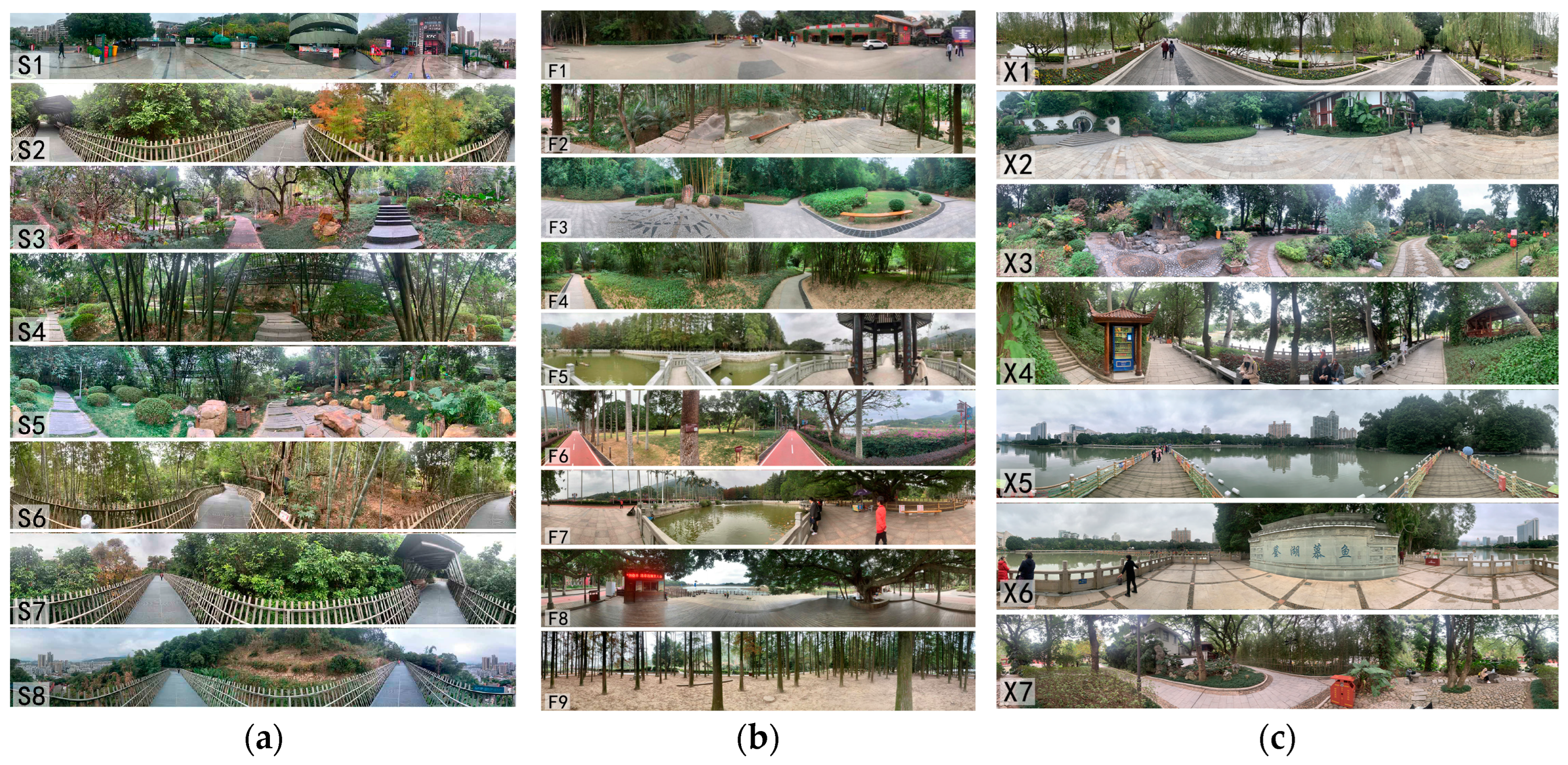
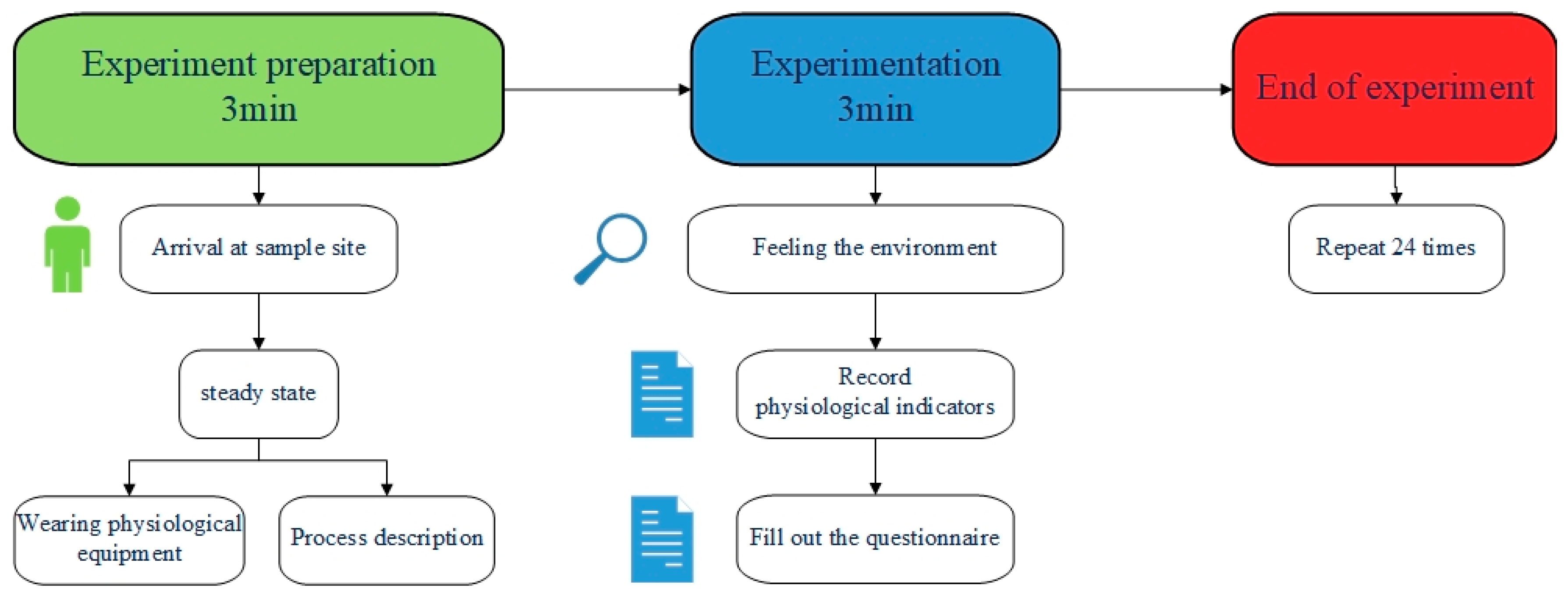
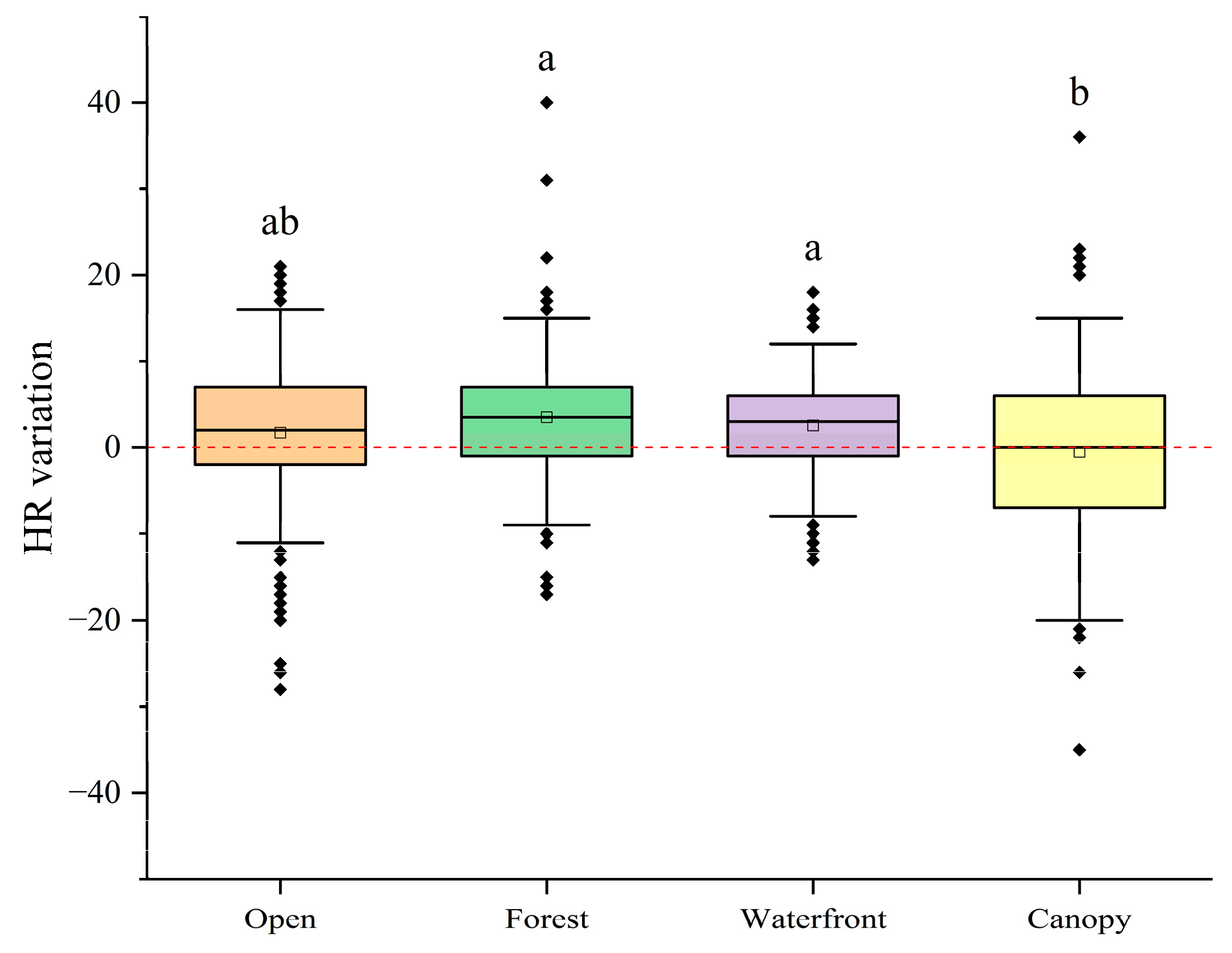
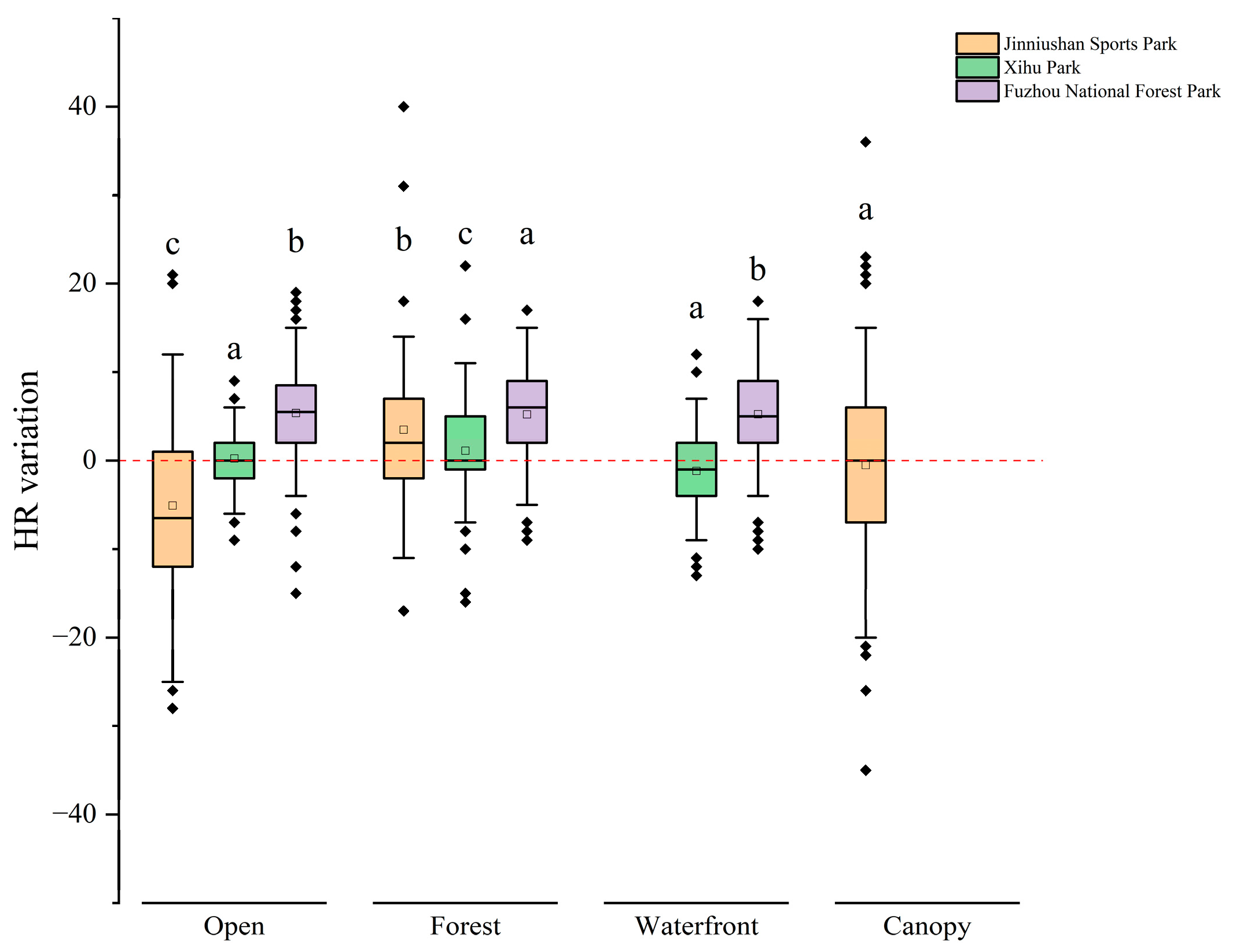
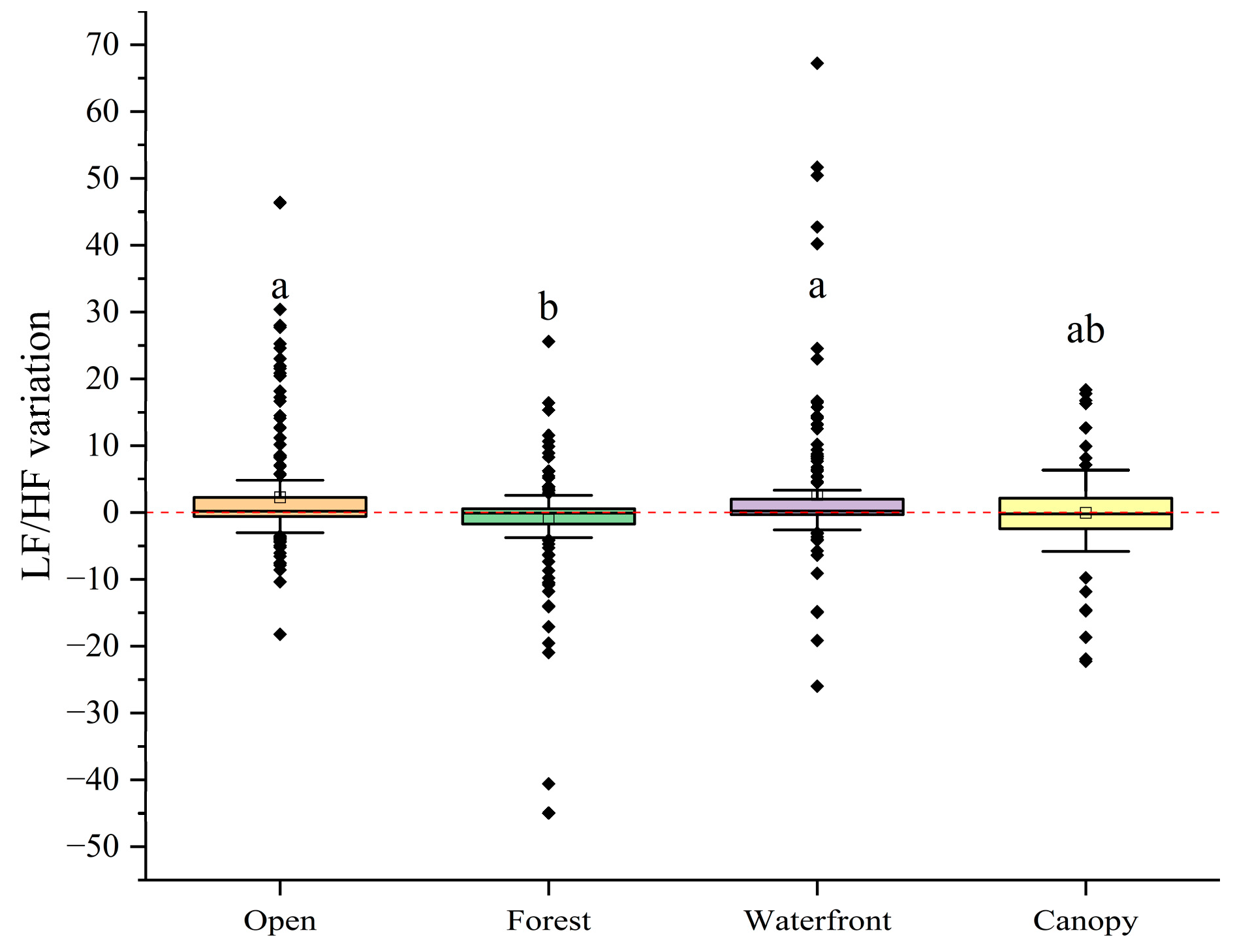

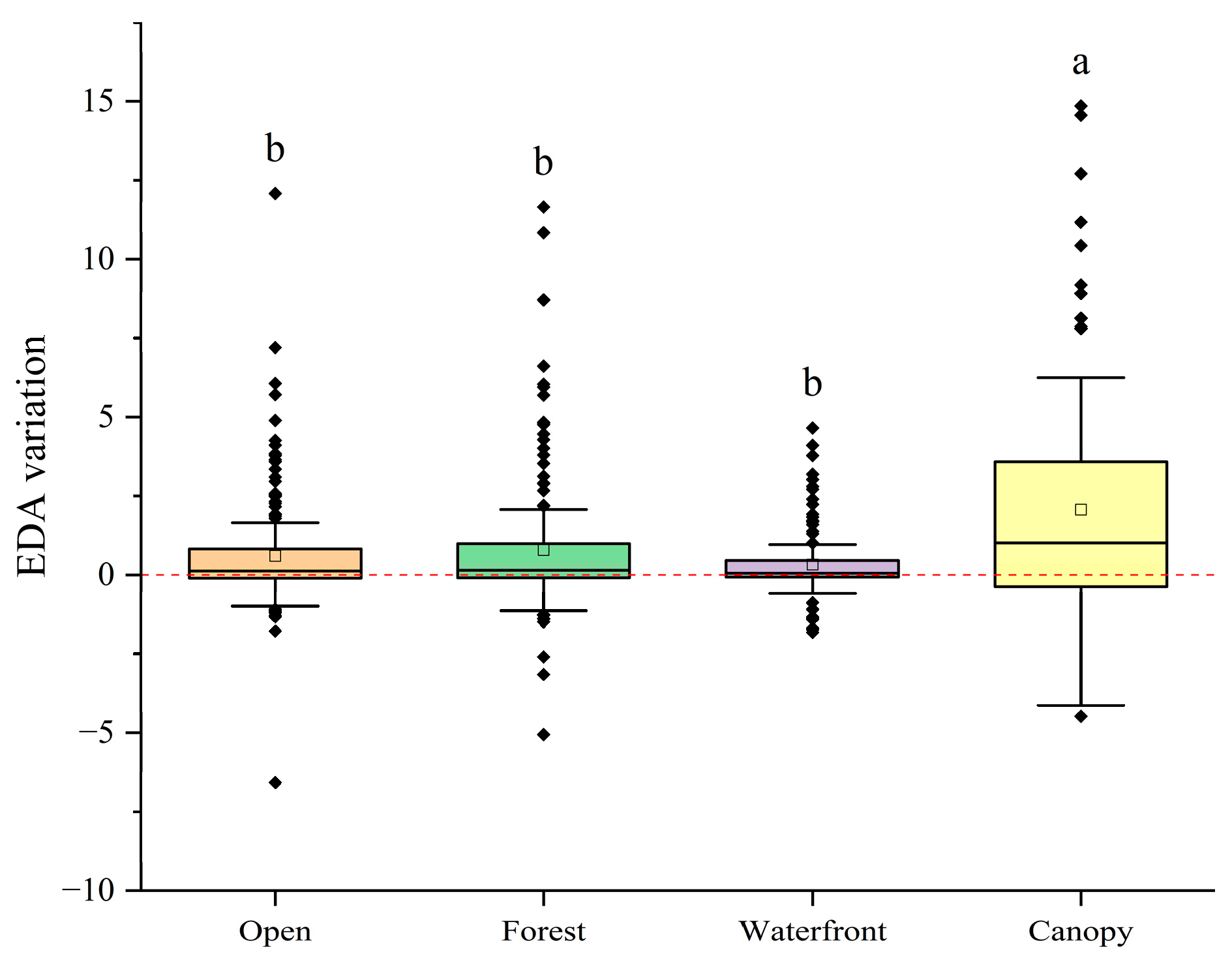
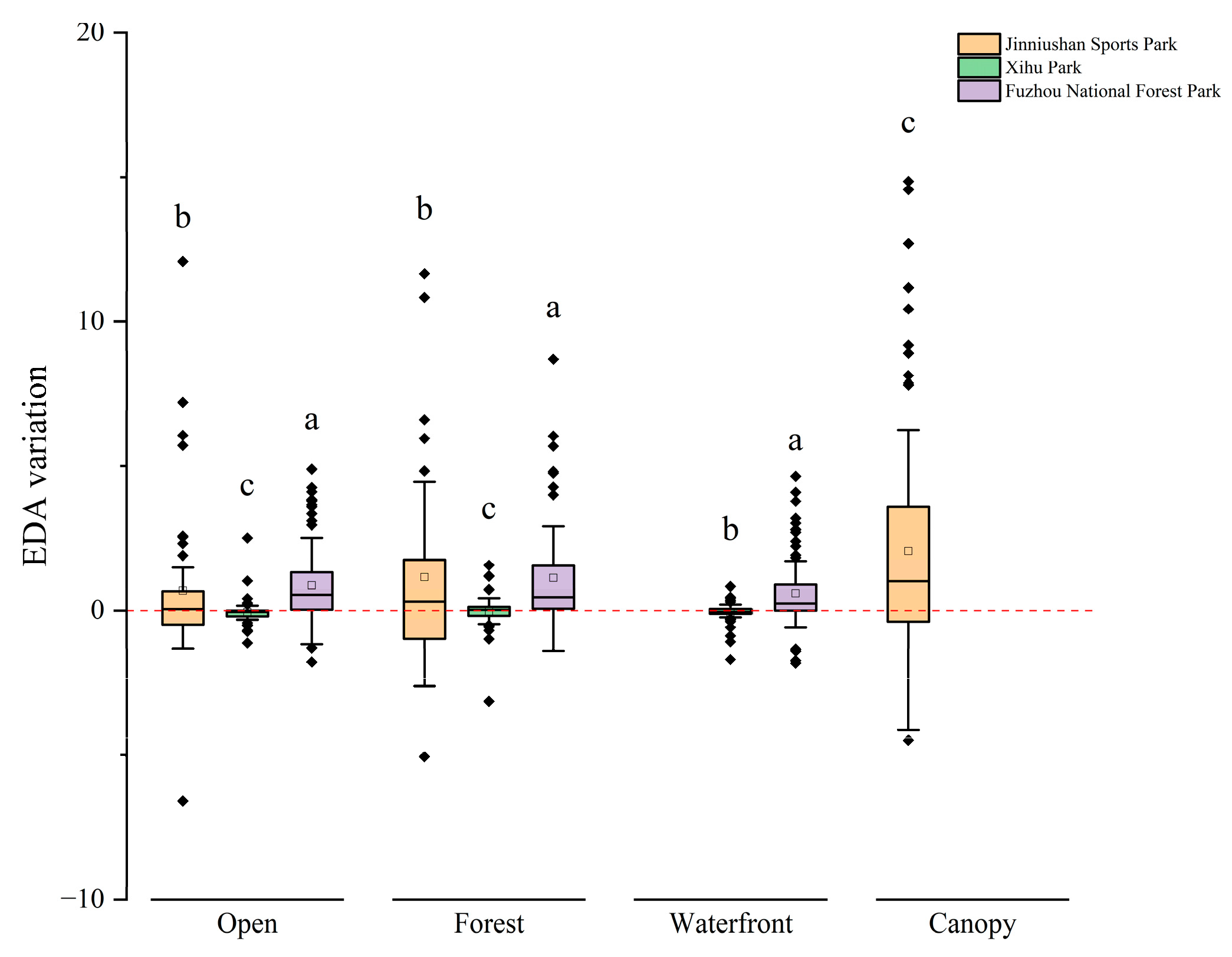

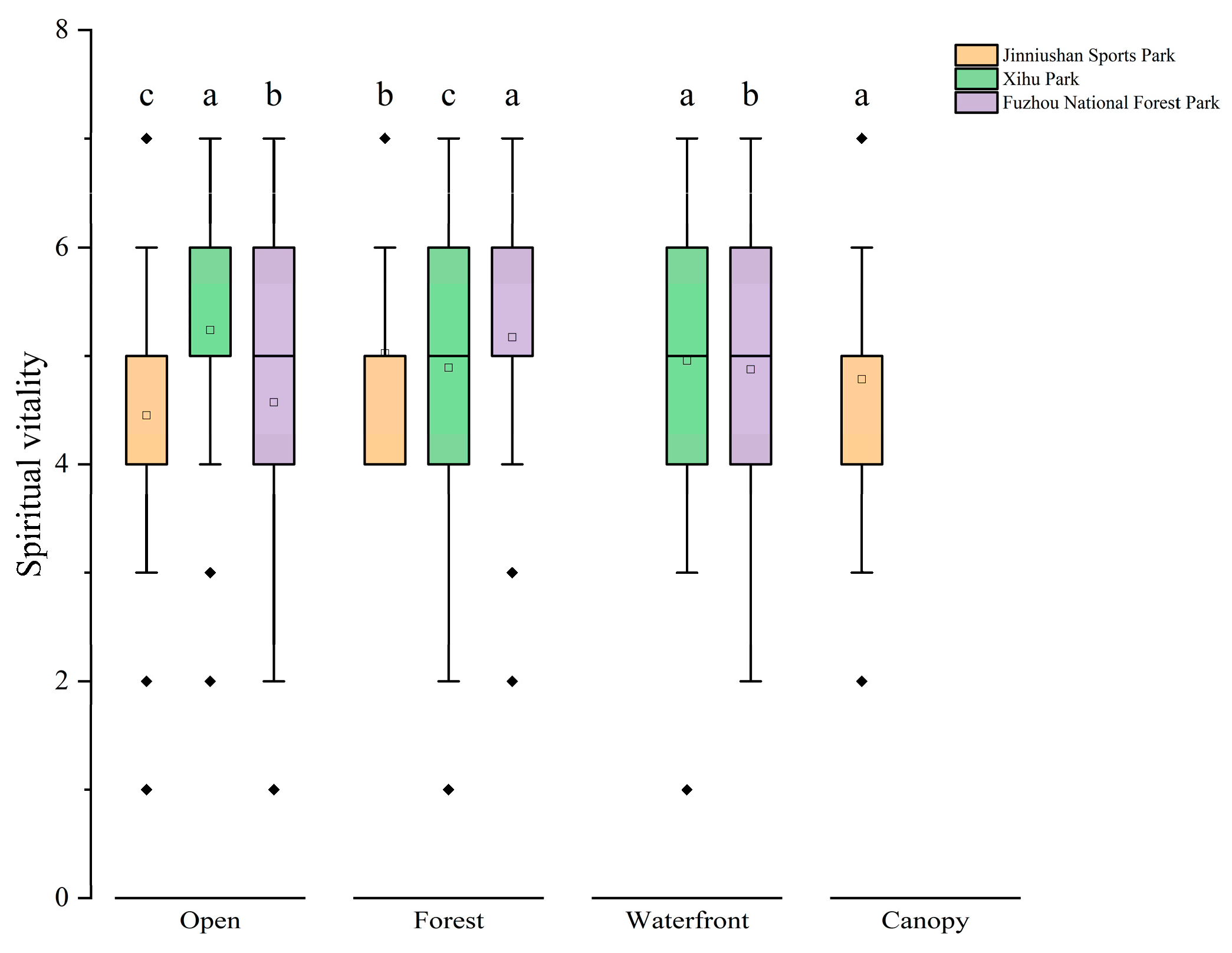
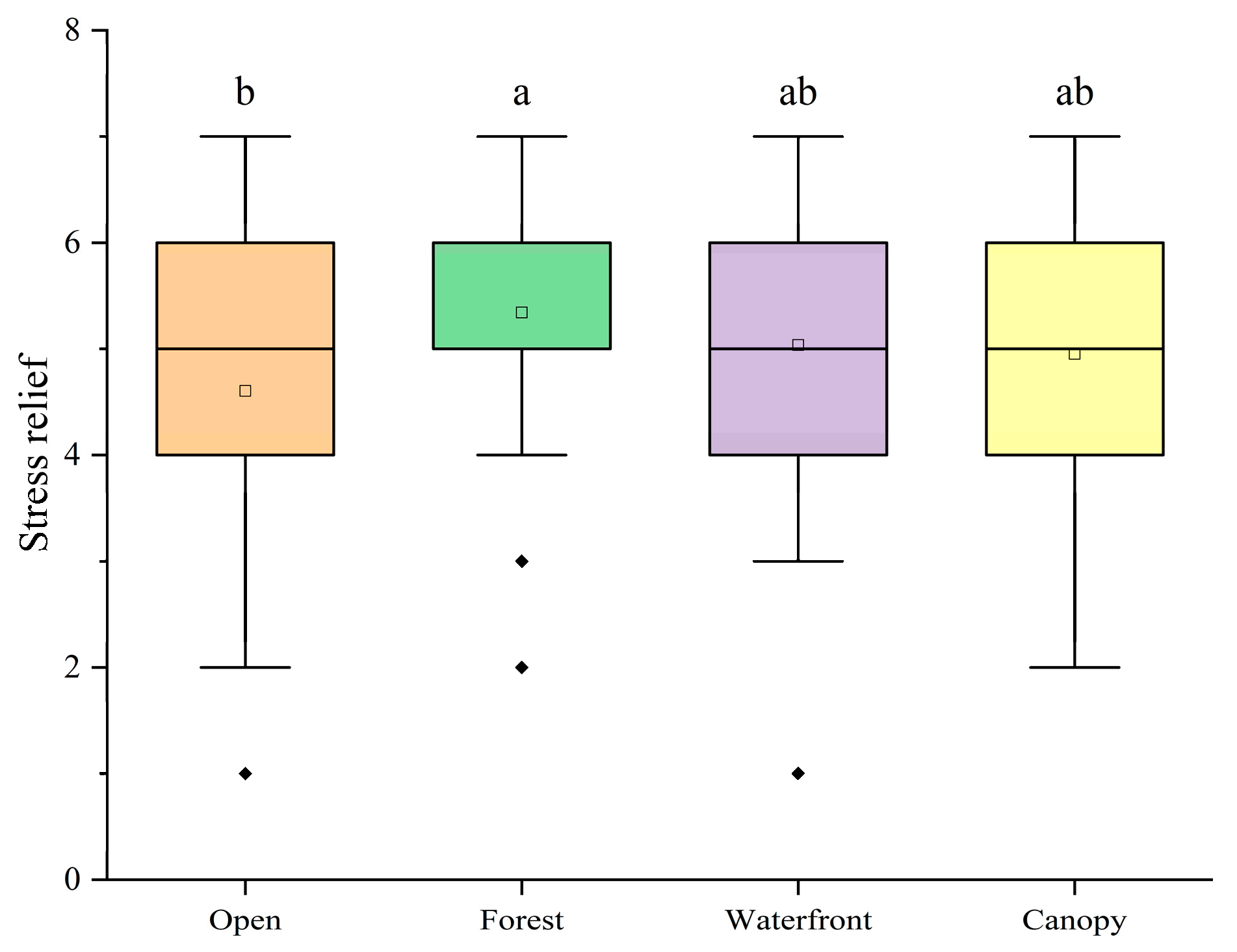
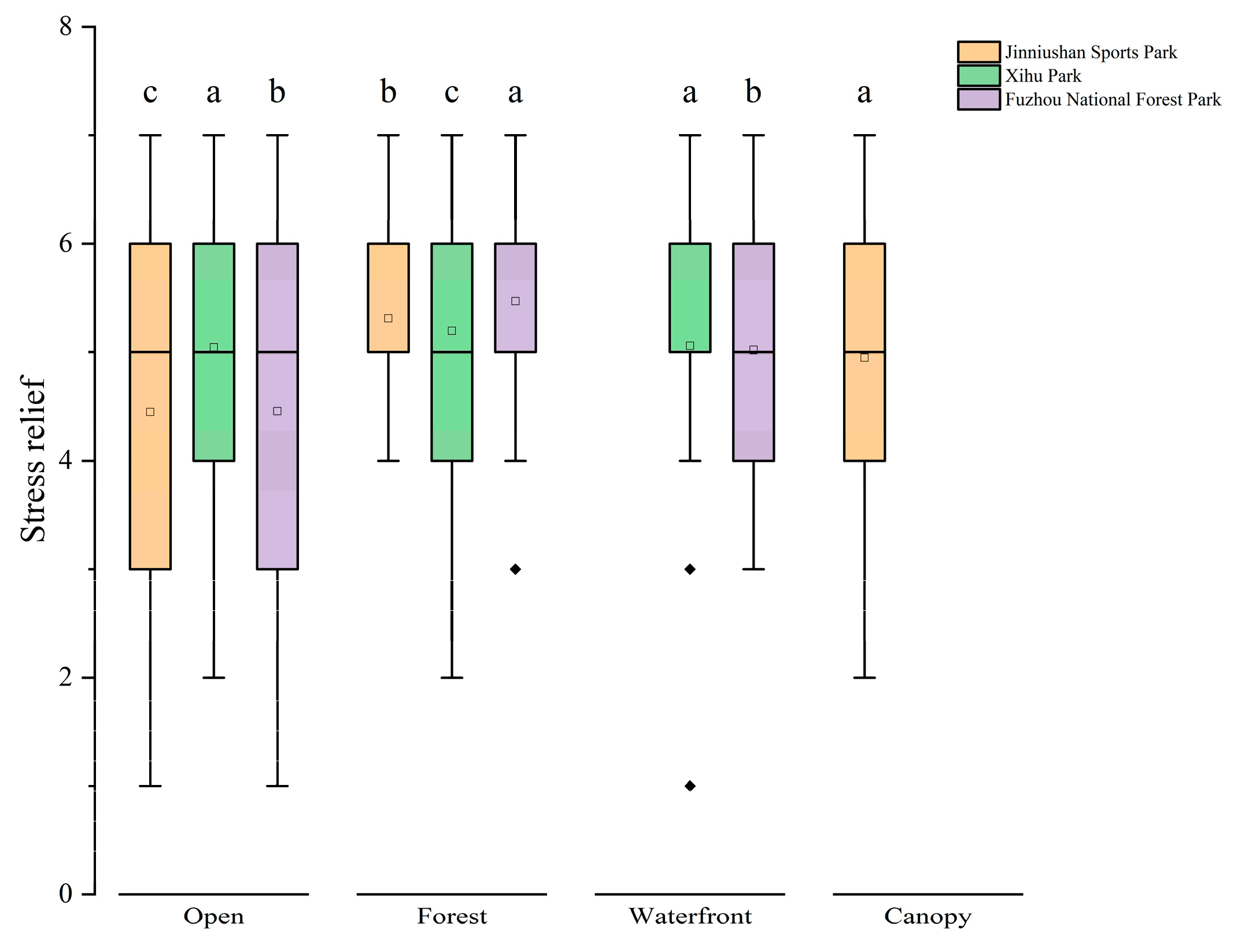

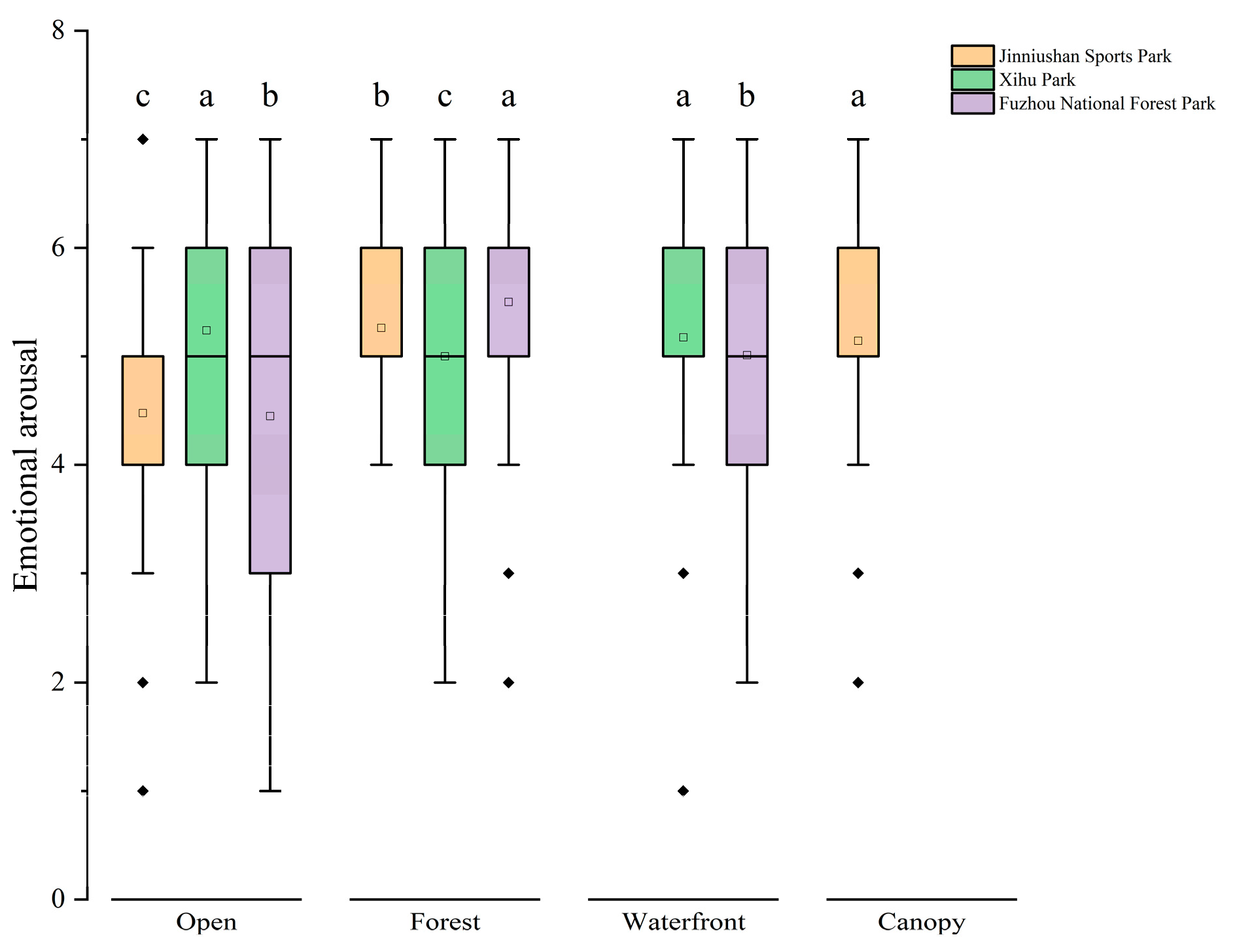
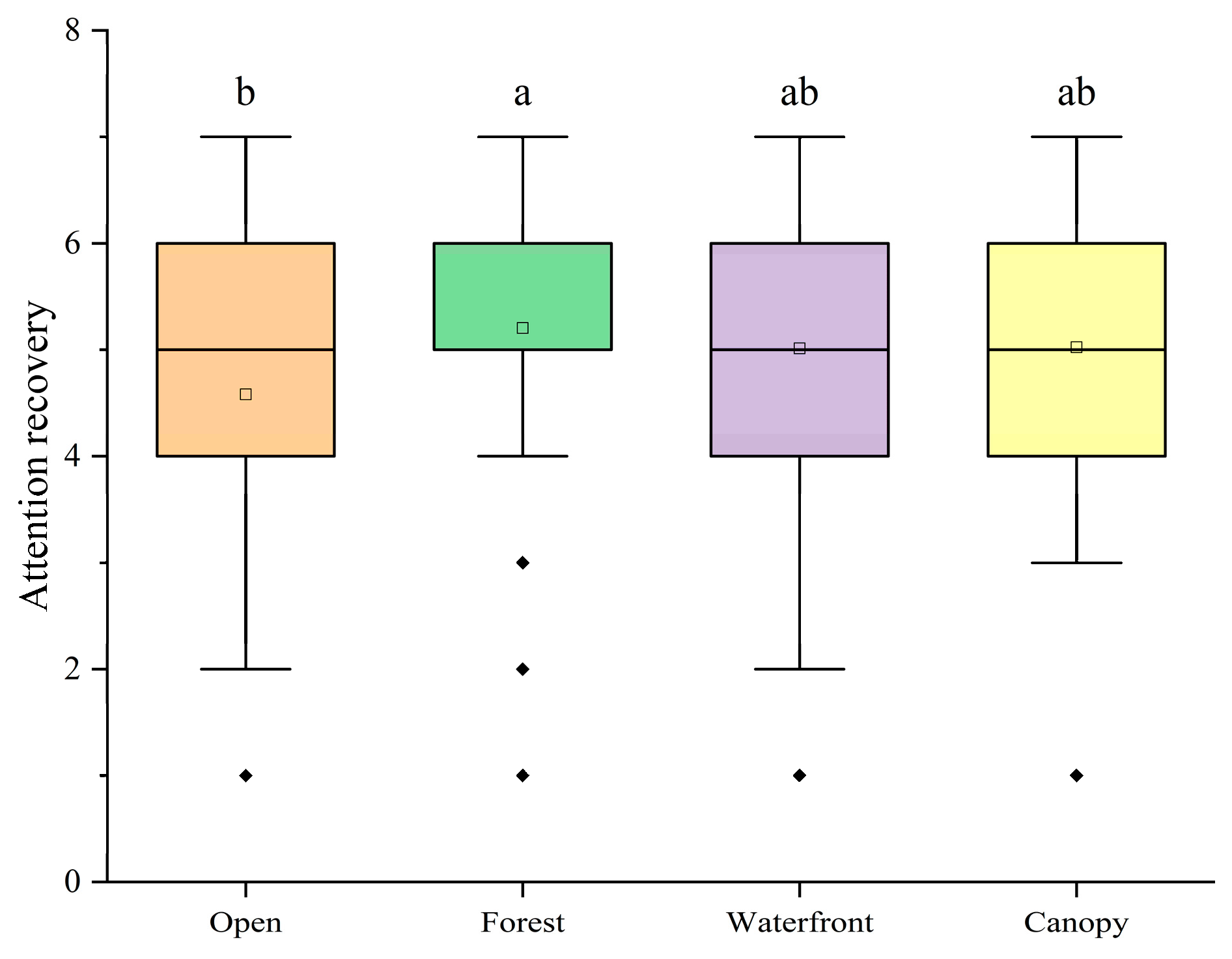
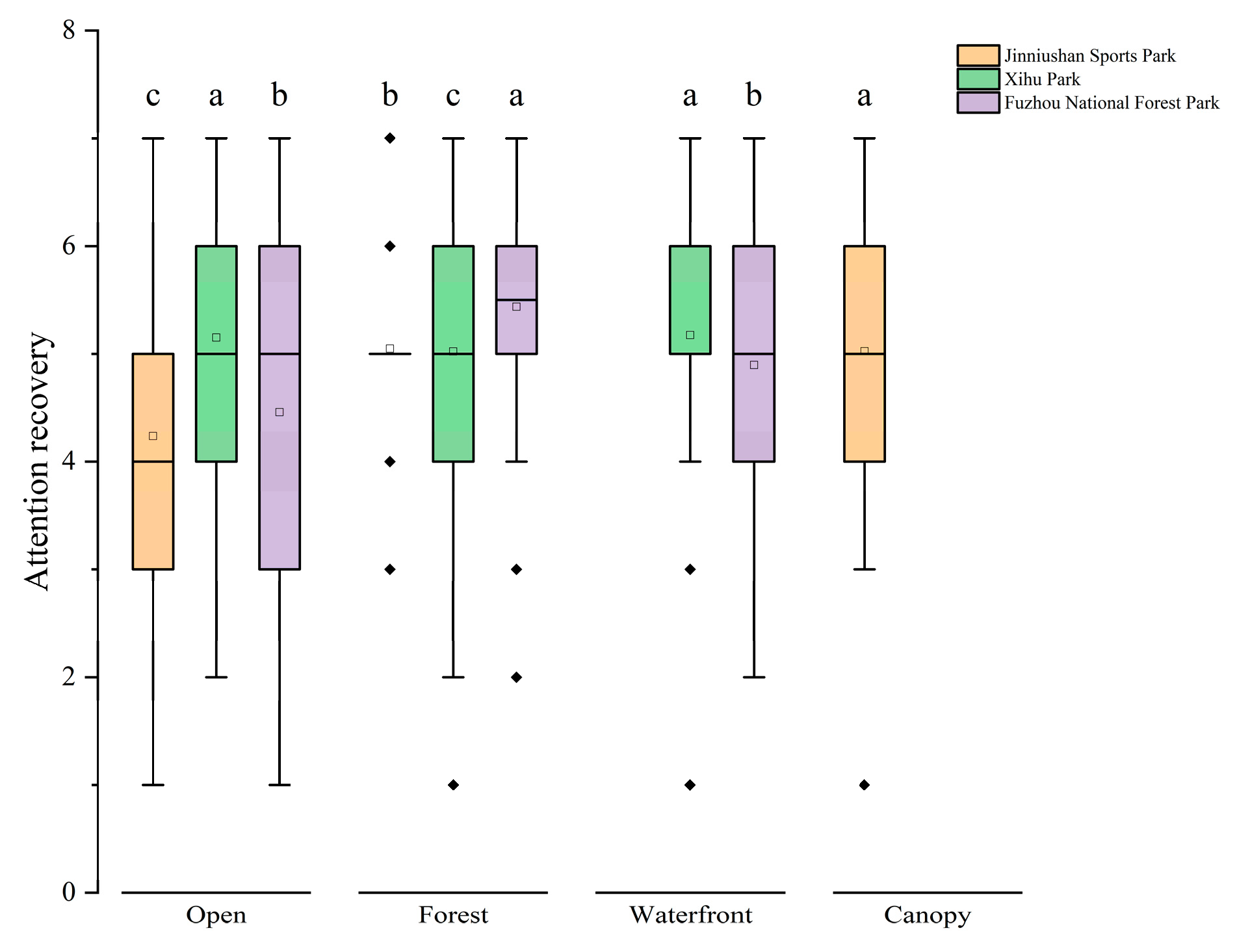

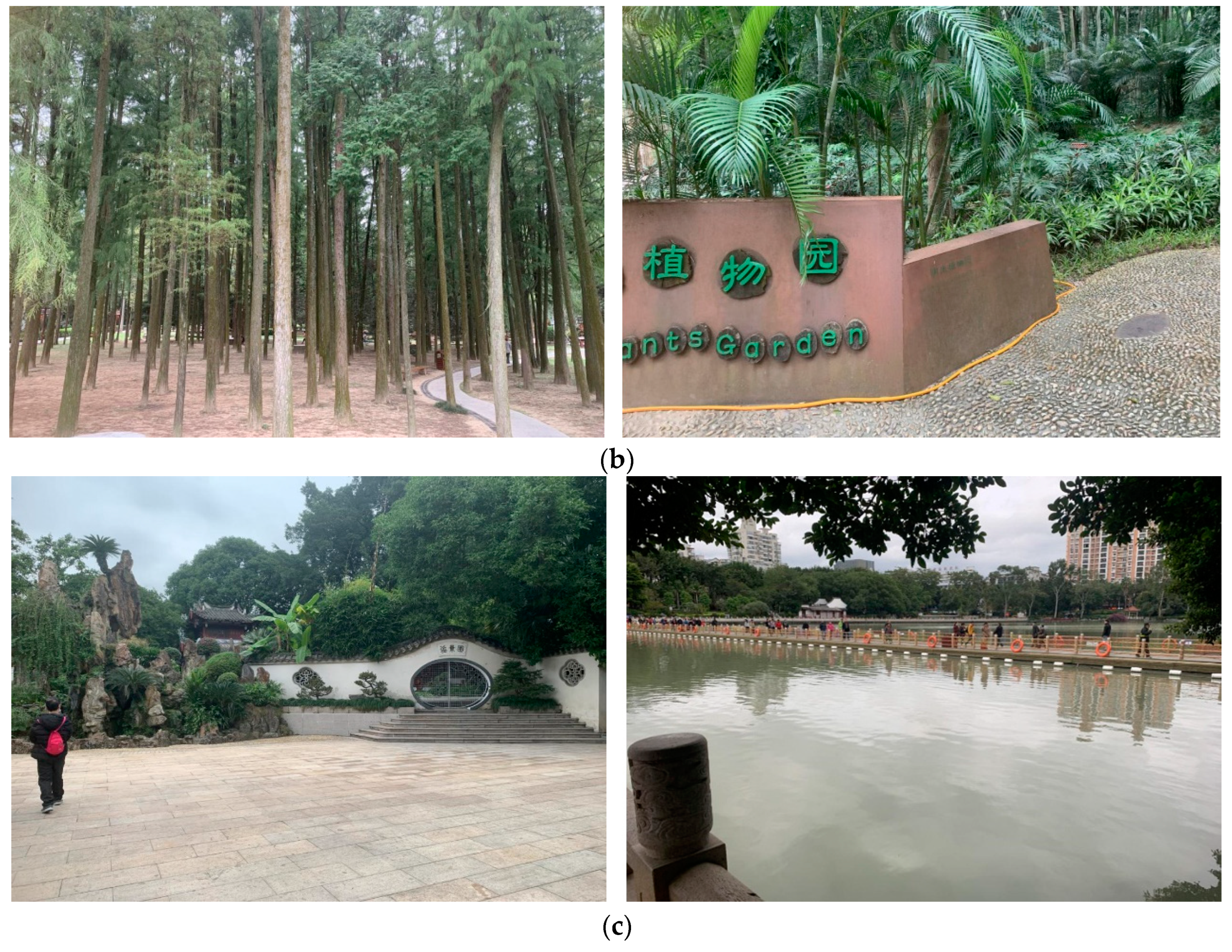
| Jinniushan Sports Park | Fuzhou National Forest Park | Xihu Park | |
|---|---|---|---|
| Overview | Defined by its rolling landscape and scenic beauty, it stands as the largest community-based semi-hilly sports park in downtown Fuzhou, acting as the gateway at Fudao Gate 3. | Fuzhou National Forest Park, alternatively referred to as “Fuzhou Botanical Garden”, is the premier national-level forest park in Fujian Province, ranking among China’s top ten forest parks and is one of the six 4A-rated tourist attractions in the Fuzhou region. The park’s comprehensive planning extends over an area of 2891.3 hm2, with a watershed covering 13 km2. | Situated in the northwest sector of Gulou District within Fuzhou City, near the city’s core, the existing land coverage amounts to 42.51 hm2, with terrestrial space constituting 12.21 hm2 and water bodies encompassing 30.3 hm2. |
| Open recreation place | S1, S5 | F1, F3, F7 | X2, X3 |
| Forest recreation place | S3, S4 | F4, F9 | X4, X7 |
| Waterfront recreation place | - | F5, F6, F8 | X1, X5, X6 |
| Canopy recreation place | S2, S6, S7, S8 | - | - |
| Measurement Index | Measuring Range | Precision | Response Time |
|---|---|---|---|
| PM2.5 | 0–999 μg/m3 | ±10% | ≤60 s |
| PM10 | 0–1500 μg/m3 | ±10% | ≤60 s |
| CO2 | 400–60,000 ppm | ±50 ppm ± 3% current reading | <60 s |
| H2S | 0–100 ppm | 0.70 ± 0.15 ppm | ≤30 s |
| O2 | 0~25% Vol. | At 5%CO2, percent change/CO2 concentration 0.1 | <15 s |
| SO2 | 0–10 ppm | 0.75 ± 0.15 ppm | <30 s |
| Air temperature | −40–80 °C | ±3% | ≤60 s |
| Air humidity | 0–100%RH | ±3% | ≤60 s |
| Illuminance | 0–65,535 Lux/0–200 k Lux | ±5% (25 °C) | ≤60 s |
| Atmospheric pressure | 30 kPa~120 kPa | 700~ 100 millibar (−1.5~+1.5) | ≤5 s |
| Wind speed | 0~60 m/s | ±0.3 m/s | ≤0.5 s |
| Wind direction | 8 directions | ≤0.5 s | |
| Ultraviolet ray | 0–3280 w/m2 | 5 μW/cm2 | ≥125 ms |
| Psychological Indicators | Basic Significance |
|---|---|
| Spiritual vitality | The mental vitality of the individual in the environment [48]. |
| Stress relief | Individuals can release effective pressure in their environment [49]. |
| Emotional arousal | Subsequent to their exposure to the specified environment, individuals experience a reduction and release of negative emotions like anxiety, resulting in a stabilization of their emotional condition [50]. |
| Attention recovery | Natural environments facilitate the restoration of attentional resources in the human brain and possess the ability to promote positive emotions, alleviate stress, and mitigate mental fatigue. Natural spatial environments that adhere to the four fundamental characteristics of being away, rich, engaging, and compatible possess attention restoration capabilities [51]. |
| Park Name | Plot Number | Temperature (°C) | Humidity (%) | Wind Speed (m/s) | PM2.5 (μg/m³) | PM10 (μg/m³) | Negative Oxygen Ion (ions/cm³) |
|---|---|---|---|---|---|---|---|
| Jinniushan Sports Park | S1 | 22.15 | 57.28 | 0.04 | 30.19 | 32.58 | 1.92 |
| S2 | 19.51 | 51.18 | 0.01 | 18.97 | 21.47 | 2.41 | |
| S3 | 19.29 | 51.31 | 0.07 | 18.43 | 20.74 | 3.18 | |
| S4 | 19.07 | 52.45 | 0.05 | 20.02 | 21.63 | 3.71 | |
| S5 | 21.02 | 62.79 | 0.03 | 28.78 | 30.83 | 2.91 | |
| S6 | 19.04 | 50.49 | 0.03 | 19.51 | 21.09 | 2.54 | |
| S7 | 19.29 | 51.21 | 0.01 | 19.42 | 21.17 | 2.60 | |
| S8 | 22.33 | 48.72 | 0.14 | 19.69 | 21.43 | 1.87 | |
| Fuzhou National Forest Park | F1 | 21.91 | 60.88 | 0.03 | 15.67 | 16.83 | 2.76 |
| F2 | 22.00 | 61.78 | 0.08 | 15.17 | 16.26 | 4.20 | |
| F3 | 22.04 | 61.61 | 0.18 | 14.96 | 15.91 | 3.55 | |
| F4 | 22.29 | 60.96 | 0.07 | 15.27 | 16.31 | 3.89 | |
| F5 | 22.28 | 59.33 | 0.09 | 15.19 | 16.14 | 2.48 | |
| F6 | 22.37 | 60.31 | 0.12 | 15.00 | 16.05 | 2.74 | |
| F7 | 22.32 | 61.17 | 0.15 | 14.76 | 15.69 | 2.78 | |
| F8 | 22.38 | 59.75 | 0.14 | 14.94 | 15.92 | 2.41 | |
| F9 | 22.03 | 60.61 | 0.15 | 15.17 | 16.11 | 3.89 | |
| Xihu Park | X1 | 18.31 | 64.16 | 0.12 | 40.54 | 41.89 | 1.50 |
| X2 | 18.56 | 63.22 | 0.02 | 43.42 | 44.58 | 2.04 | |
| X3 | 18.62 | 64.05 | 0.00 | 42.57 | 43.89 | 1.94 | |
| X4 | 18.75 | 62.56 | 0.03 | 42.25 | 43.11 | 2.15 | |
| X5 | 18.60 | 62.69 | 0.21 | 44.80 | 45.64 | 0.96 | |
| X6 | 18.55 | 62.61 | 0.15 | 42.01 | 43.22 | 1.46 | |
| X7 | 18.44 | 63.07 | 0.05 | 40.85 | 42.08 | 2.16 |
| Physiology/Psychology Response | Temperature | Humidity | Wind Speed | PM2.5 | Negative Oxygen Ion | R2 |
|---|---|---|---|---|---|---|
| HR | −1.127 ** | 0.462 *** | 11.694 ** | −0.386 *** | - | 0.118 |
| LF/HF | 0.797 *** | - | - | - | - | 0.019 |
| EDA | - | −0.098 *** | - | −0.024 ** | - | 0.080 |
| Spiritual vitality | −0.152 *** | - | 2.661 ** | - | 0.244 *** | 0.035 |
| Stress relief | −0.213 *** | - | 3.388 *** | - | 0.392 *** | 0.063 |
| Emotional arousal | −0.193 *** | - | 2.878 ** | - | 0.307 *** | 0.044 |
| Attention recovery | −0.215 *** | - | 3.649 *** | - | 0.321 *** | 0.055 |
Disclaimer/Publisher’s Note: The statements, opinions and data contained in all publications are solely those of the individual author(s) and contributor(s) and not of MDPI and/or the editor(s). MDPI and/or the editor(s) disclaim responsibility for any injury to people or property resulting from any ideas, methods, instructions or products referred to in the content. |
© 2024 by the authors. Licensee MDPI, Basel, Switzerland. This article is an open access article distributed under the terms and conditions of the Creative Commons Attribution (CC BY) license (https://creativecommons.org/licenses/by/4.0/).
Share and Cite
Lan, Y.; Wang, J.; Huang, Y.; Tang, Y.; Liu, Z.; Zheng, J.; Yao, X.; Zhu, Z.; Dong, J.; Chen, Y. The Combined Effects of the Thermal Environment and Air Quality at Recreation Places on the Physiology and Psychology of People in Urban Parks. Forests 2024, 15, 1640. https://doi.org/10.3390/f15091640
Lan Y, Wang J, Huang Y, Tang Y, Liu Z, Zheng J, Yao X, Zhu Z, Dong J, Chen Y. The Combined Effects of the Thermal Environment and Air Quality at Recreation Places on the Physiology and Psychology of People in Urban Parks. Forests. 2024; 15(9):1640. https://doi.org/10.3390/f15091640
Chicago/Turabian StyleLan, Yuxiang, Jingjing Wang, Yaling Huang, Yuanyang Tang, Zhanhua Liu, Jiahui Zheng, Xiong Yao, Zhipeng Zhu, Jianwen Dong, and Ye Chen. 2024. "The Combined Effects of the Thermal Environment and Air Quality at Recreation Places on the Physiology and Psychology of People in Urban Parks" Forests 15, no. 9: 1640. https://doi.org/10.3390/f15091640
APA StyleLan, Y., Wang, J., Huang, Y., Tang, Y., Liu, Z., Zheng, J., Yao, X., Zhu, Z., Dong, J., & Chen, Y. (2024). The Combined Effects of the Thermal Environment and Air Quality at Recreation Places on the Physiology and Psychology of People in Urban Parks. Forests, 15(9), 1640. https://doi.org/10.3390/f15091640








